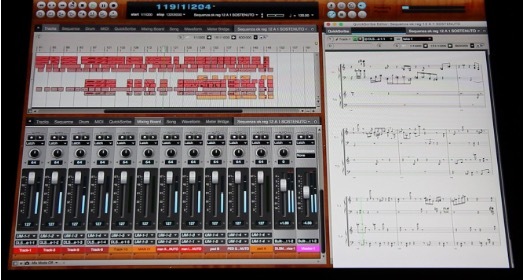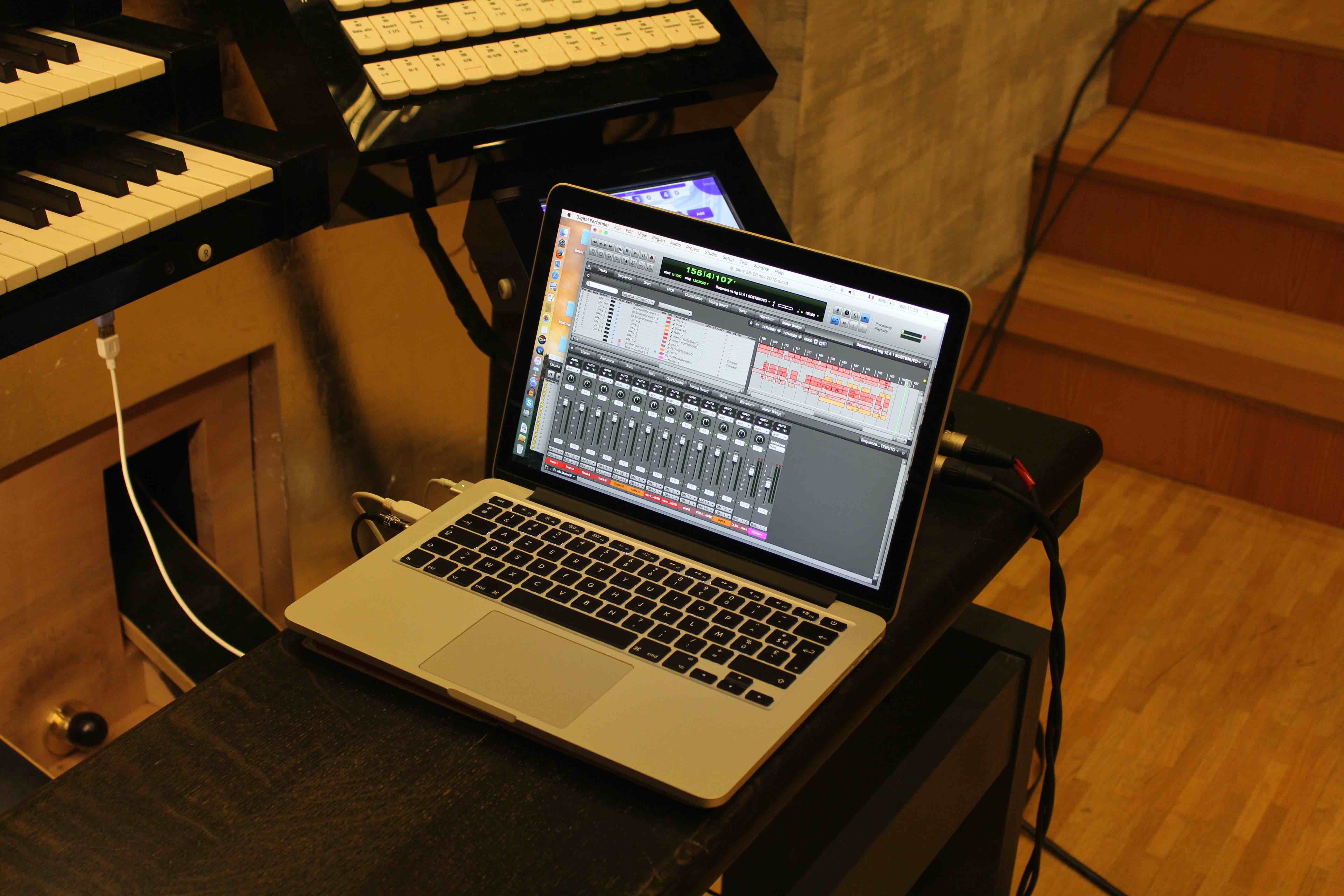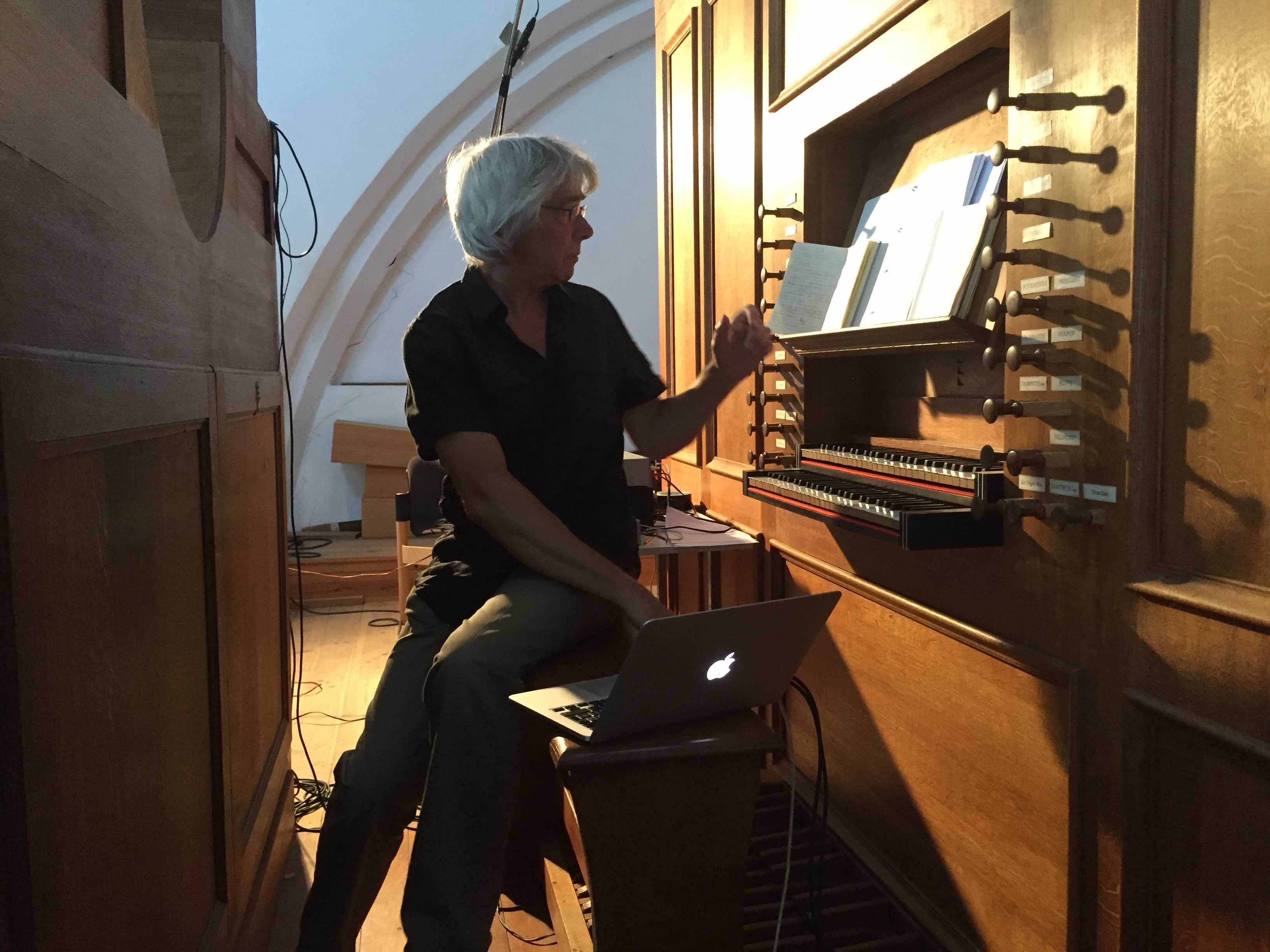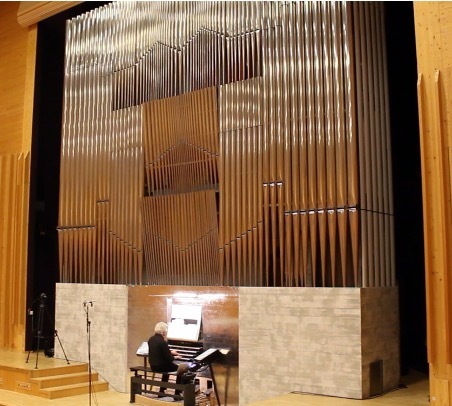PipesandSpeakers
The PipesandSpeakers project was initiated in 2005 when Joris Verdin presented a program Organ and Synthesizers in the Lemmens Institute, on invitation by "De Nieuwe Reeks". It was a first experience to combine a pipe organ with synthesizers in real time, through the MIDI connection of the console. The essential technical support was designed by Jean-Marc Sullon, from the "Centre Henri Pousseur Liège". In the following years Joris Verdin developed his own way of using modern sounds to complement the original pipe organ. The experience was repeated in Leuven in 2007 and this new step stimulated new experiences, in spite of the lack of more organs with a digital console. Some years later, larger organs with MIDI connections, were installed in the Orgelpark Amsterdam, the Acusticum concert hall in Piteå and in Göteborg Symphony Konserthus Sweden. They created the opportunity to present the possibilities of organ and synthesizer to a larger audience.

PipesandSpeakers has the goal to be a complement to the Augmented or Hyper Organ. The starting point is to find a way of introducing contemporary existing sounds into the world of the pipe organ, the sound that started with the first analog synthesizers.
The basic idea is "simplicity". Although this seems to be utopian, neither a large organ or a synthesizer is simple, the set up is simple and clear: a laptop and a PA system. The software of the computer controls the addition of digital sound, chosen and prepared by the player. It makes the organ sound as it never could be without this combination of genuine modern sounds with genuine organ stops. At the same time, the computer can make the organ play musical phrases or entire compositions that even the most skilled player is unable to. For examples on vimeo, see links.
Organ and Digital Sound Processing
In 2019 the AULO Symposium was organized by the Sorbonne Université and the Conservatoire de Paris. Since no organ with MIDI was available, it was the start of a new track in PipesandSpeakers: using digital sound processing in real time, with the help of microphones, a sound system and a laptop. The principle of simplicity remains the main idea, translated in the use of consumer friendly affordable software. In this context, standard effects taken from popular music are a basic element in combining acoustical sounds with digital processing. The sound of the organ is not new, neither are the basic effects, but the combination is.
In February 2020 the PipesandSpeakers project was part of NextDoors in the Royal Conservatoire of Antwerp. It was announced as follows: "For keyboard players, composers, DSP freaks, and all those who would like to use the organ not only as an organ. The organ will be augmented with mikes, interface, sound system and speakers. Between them all kinds of Digital Sound Processing are possible. Bring your compositions or drafts of pieces in which you imagine the sound of pipes being used in a personal way. The sound of pipes can be as it is, but it can also be modulated by using different ways of shaping the wind pressure, as the source of your patch. If you are using DAW, come and connect your laptop to the system in the organ. If you don't use DSP yet, come and see what is possible in transforming or augmenting the organ sound with digital effects."
In June 2020 the restrictions created a unique opportunity: Leuven Orgelstad made it possible to install microphones and a sound system in the organ loft of the Predikherenkerk. Leuven Orgelstad created an exceptionally favorable situation to explore the possibilities of the Van Peteghem organ with digital sound processing, using a extremely limited setup, two microphones and a basic sound system. Recordings available on vimeo.
A most important element in the project is the live experience. Recordings and videos can only reproduce a very small impression of the effects in the real situation: the integration of loudspeakers in a large acoustical instrument.

Note
PipesandSpeakers focuses on combining the acoustical organ sound with the loudspeaker sound of a synthesizer or any sound processor through microphones, but not excluding computer generated music. Loudspeakers are part of the basic setup. Doing so, it is different from the current tendencies of the Hyper Organ or Augmented Organ. Those approaches concentrate on implementing algorithms, on controlling the organ action and sound production directly without the addition of loudspeakers.
Orgue et synthétiseurs, connectés via MIDI
Le projet PipesandSpeakers a été initié en 2005 lorsque Joris Verdin a présenté un programme orgue et synthétiseurs à l'Institut Lemmens, à l'invitation de "De Nieuwe Reeks". C'était une première expérience de combinaison d’un orgue à tuyaux avec des synthétiseurs en temps réel, via la connexion MIDI de la console. L'essentiel du support technique a été conçu par Jean-Marc Sullon, du "Centre Henri Pousseur Liège". Au cours des années suivantes, Joris Verdin a développé sa propre façon d'utiliser des sons modernes pour compléter l'orgue à tuyaux d'origine. L'expérience a été répétée à Louvain en 2007 et cette nouvelle étape a stimulé de nouvelles expériences, malgré le nombre limité d’orgues disposant d’une console numérique. Quelques années plus tard, des orgues plus grands avec des connexions MIDI ont été installés à l'Orgelpark Amsterdam, dans la salle de concert Acusticum à Piteå et au Göteborg Symphony Konserthus Suède. Ces instruments créent l'occasion de présenter les possibilités de l'orgue et du synthétiseur à un public plus large.
PipesandSpeakers a pour objectif d'être un complément à l'Orgue augmenté ou Hyper-Organ. Le point de départ est de trouver un moyen d'introduire des sons contemporains existants, les sons qui ont commencé avec les premiers synthétiseurs analogiques, dans le monde de l'orgue à tuyaux.

L'idée de base est la "simplicité". Bien que cela semble être une utopie, car ni un grand orgue ni un synthétiseur ne sont simples, la configuration, elle, se veut simple et claire : un ordinateur portable et un système de sonorisation. Le logiciel de l'ordinateur contrôle l'ajout de son numérique, choisi et préparé par le musicien. Il fait sonner l'orgue comme il ne serait pas possible de le faire sans cette combinaison de véritables sons modernes avec de véritables jeux d'orgue. En même temps, l'ordinateur peut faire jouer à l’orgue des phrases musicales ou des compositions entières que même l’organiste le plus habile ne pourrait réaliser. Pour des exemples, voir les liens.
Orgue et traitement numérique du son
En 2019, le Colloque AULO, augmenter l’orgue, a été organisé par Sorbonne Université et le Conservatoire de Paris. Aucun orgue avec MIDI n'était disponible. Ce fut alors le début d’un nouveau chapitre pour PipesandSpeakers : utiliser le traitement numérique du son en temps réel, à l'aide de microphones, d'un système de sonorisation et d'un ordinateur portable. Le principe de simplicité reste l'idée principale, traduite dans l'utilisation de logiciels abordables. Dans ce contexte, les effets standards issus de la musique populaire sont un élément fondamental pour combiner les sons acoustiques avec le traitement numérique. Le son de l'orgue n'est pas nouveau, les effets de base non plus, mais la combinaison l'est.

En février 2020, le projet PipesandSpeakers faisait partie du Festival NextDoors au Conservatoire Royal d'Anvers. Y ont participé des claviéristes, des compositeurs, des passionnés de traitement du son et tous ceux qui aimaient utiliser l'orgue non seulement comme orgue. En juin 2020, les restrictions ont créé une opportunité unique : Leuven Orgelstad a permis d'installer des microphones et un système de sonorisation dans la tribune d'orgue de la Predikherenkerk. Leuven Orgelstad a créé une situation exceptionnellement favorable pour explorer les possibilités de l'orgue Van Peteghem avec traitement numérique du son, en utilisant une configuration extrêmement limitée, deux microphones et un système de sonorisation de base.
L'expérience en direct est l'un des éléments les plus importants du projet. Les enregistrements et les vidéos ne peuvent reproduire qu'une toute petite impression des effets en situation réelle. PipesandSpeakers se concentre sur la combinaison du son de l'orgue acoustique avec le son du haut-parleur d'un synthétiseur ou de tout processeur de son via des microphones, mais n'exclut pas la musique générée par ordinateur. Les haut-parleurs font partie de la configuration de base. Ce faisant, PipesandSpeakers se démarque des tendances actuelles de l'Hyper Organ, des approches qui se concentrent sur la mise en œuvre d'algorithmes, sur le contrôle direct de l'action de l'orgue et de la production sonore sans l'ajout de haut-parleurs.
Links
Organ and DSP, recorded 2020 in Predikherenkerk, Leuven, Belgium
Organ and DSP, recorded 2015 Positive Debierre 1870
- Destination 8 Autobahn 2
Organ and Synthesizer, recorded 2016 in Studio Acusticum, Piteå, Sweden
Organ and Synthesizer, recorded 2019 in Brussels - Bozar
- Destination 5 Autobahn 4
automation play
Organ and MIDI, recorded 2023 in Göteborg Symphony, Rieger IV/P

Overview events:
2005 February "De nieuwe reeks" Leuven (BE)
2007 March Lemmensinstituut Leuven
2016 June Orgelpark Amsterdam
2016 December Studio Acusticum Piteå (SE)
2019 June Orgelpark Amsterdam
2019 October Colloque AULO, Sorbonne Université, Paris
2021 June Leuven Orgelstad Residence
2022 July Concert Predikherenkerk Leuven Orgelstad
2023
12-14 February Göteborg (SE) Organ&MIDI in GSO Concert Hall (Recording Demo part 1)
25 June Herentals (BE) Waldetrudis
28-31 July Göteborg (SE) Organ & MIDI in GSO Concert Hall (Recording Demo part 2)
12-13 August Auch (FR) in collaboration with Modus
18-19-20 August Brugge (BE) Reiefestival Soundtrack Locus Iste - Benjamin Verdonck
8 October Cannes/Mougins (FR) Festival Orgue & Électronique
28 October Bodegem (BE) Musica@parola
12 November Brasschaat (BE)
2024
15-17 January Marmoutier Residence Organum XXI
8 June Orgelpark Amsterdam
